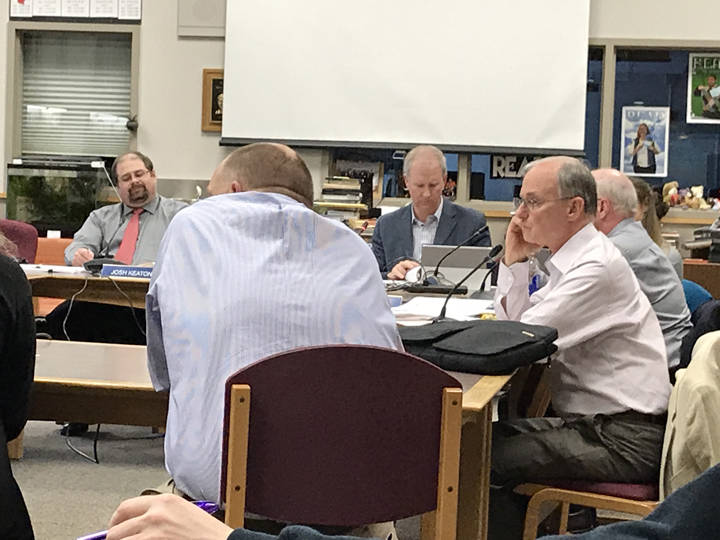The Juneau school board on Tuesday heard plans to create a Tlingit Language Revitalization Task Force.
Ted Wilson, Director of Teaching and Learning Support, presented the idea to the board at its regular meeting at Juneau-Douglas High School Tuesday evening.
Wilson explained he worked with Barbara Cadiente-Nelson, Juneau School District Indian Studies Program Coordinator, Hans Chester, JSD Indian Studies Cultural Specialist and Jessica Chester, JSD Tlingit Culture, Language &Literacy (TCLL) teacher, on who would be on the task force and the hopeful outcomes.
Joining those four on the task force could potentially be: one or two school board members and one elementary, one middle school and one high school principal. It will also include representation from Sealaska Heritage Institute, Goldbelt Heritage Foundation, Central Council of the Tlingit and Haida Indian Tribes of Alaska, Douglas Indian Association, Association for the Education of Young Children Southeast Alaska, University of Alaska Southeast and Tlingit Readers Inc.
School Board President Brian Holst questioned the size of the force and added that for it to be successful, outside support will be needed.
“The (force) seems too large to be efficient,” Holst said. “This (language revitalization plan) may be very powerful, but how will (the district) pay for it?”
Wilson said the task force will have to work with its Alaska Native partners — namely Goldbelt — on securing language grants to help contribute to the program. He also added that UAS has an adult Tlingit language program for adults and he would like to see the school reach out to them.
Board clerk Andi Story suggested that the task force reach out to parents and businesses for involvement in the implementation of the program. Wilson said the group would contact parents, but on the business end he “would have to think about that kind of recruitment.”
Wilson said he hopes the first meeting will help hash out details.
“One of the items we discussed at length when we talked about the first task force meeting is that we have to assume members will want to have discussion about outcomes,” Wilson said. “Some of those outcomes may need to be adjusted.”
The outcomes of the task force were outlined in a comprehensive community plan that includes: Áak’w (Auke Bay) and T’aakú (Taku Bay) Kwáan clans connections; home to school language connections; getting inventory from current community resources from speakers, language learners and curriculum; conducting a survey to determine the best practices in language teaching and learning; identify/commission a pre-K to 12 systemic plan for place-based student instruction; and develop a logic model for plan implementation.
Board member Steve Whitney added that while the goal list seems like a lot, if the district can achieve one of them, it should be considered a success.
“The goal should be to implement one of these programs,” Whitney said.
The task force will last for six months with monthly meetings starting Sept. 12 and concluding Feb. 13, 2019. The task force will present to the school board at the completion of the program.
Religious, governmental and other institutions suppressed Alaska Native languages during the 19th and 20th centuries, causing their decline. The Alaska Native Languages Center at the University of Alaska Fairbanks recognizes 20 distinct Alaska Native languages. Of those, one has no fluent speakers; another has only one fluent speaker who is more than 90 years old. All are considered threatened.
Efforts have been made in Juneau to revitalize the Tlingit, Haida and Tshimshian languages, including a language grant of nearly $1 million to SHI. The “Tlingit Language Flowing Through Generations: A Region wide Approach to Language Revitalization” grant was given for a language workshop called “Honoring Our Ancestors, Teaching Our Language.”
New science curriculum
The Board of Education unanimously approved a new science curriculum for the middle and high school during its meeting.
Board member Jeff Short brought up that anonymous email public comment was given. Five people did have concerns that the program may not seem to be that challenging, but Thunder Mountain High School science teacher Kathleen Galau assured the board that the curriculum will present solid coursework for the students.
“I would say this curriculum is much more challenging than the prior curriculum,” Galau said. “It is much broader and deeper than it was before.”
Galau explained that the new curriculum will be “STEM-rich” and will involve using experiences and reason in problem solving. STEM stands for Science, Technology, Engineering and Mathematics. Galau added that the teachers —all who have reviewed and approved the curriculum — are up to the duty of teaching it.
“The teachers are very receptive to kicking it up to make it more challenging whenever we have the opportunity,” Galau said.
Galau also added that the curriculum will involve a lot of concept building. She also said she would like to somehow get in contact with the members of the public who had concerns about the curriculum so she could speak to them about it.
School board Vice President Josh Keaton was not shy about his support of the curriculum.
“I love this,” Keaton said. “We are ahead of the game. Our initiative here will be what the Alaska science curriculum should be.”
• Contact reporter Gregory Philson at gphilson@juneauempire.com or call at 523-2265. Follow him on Twitter at @GTPhilson.

